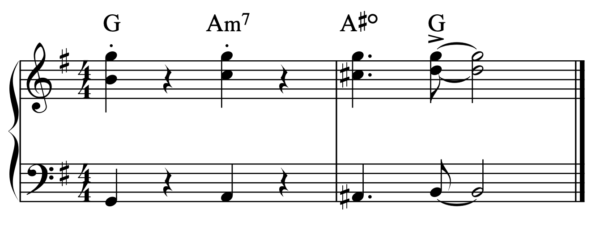Intros and outros
In this article called intros and outros I am focusing on a subject that is often overlooked when playing a tune: how to start and end a tune.
Intros and outros: intros
Let’s imagine that you are accompanying a singer or instrumentalist about to sing or play the melody. The most obvious way for the pianist to inform the the singer etc is to provide what is known as a bell note. Here are the first four bars of the song ‘I can’t give you anything but love‘.

The bell note is simply the first note of the melody.
The pianist strikes this bell note to give the singer their starting note, in this case, G.
A second approach is to supply the singer with a broken chord, usually the dominant. So in the above example, because the key is G major the broken chord will be D. However, my preference is to turn this broken dominant chord into D+, in other words D augmented: D+F#+A.

A third approach is to play either the last 8 bars or the last 4 bars as an intro.
Here are the last 8 bars of ‘I can’t give you anything but love’.

Notice that although the penultimate bar of my lead sheet only contains the chord G,
I have added E7 at beat 3 to create a 1625 for the last 2 bars.
Outros
I’m just going to give you just one suggestion here for an outro. This is a tried and trusted lick that works for the final two bars.

And here’s my YouTube video about intros and outros.
For my complete learn jazz piano video course click here.